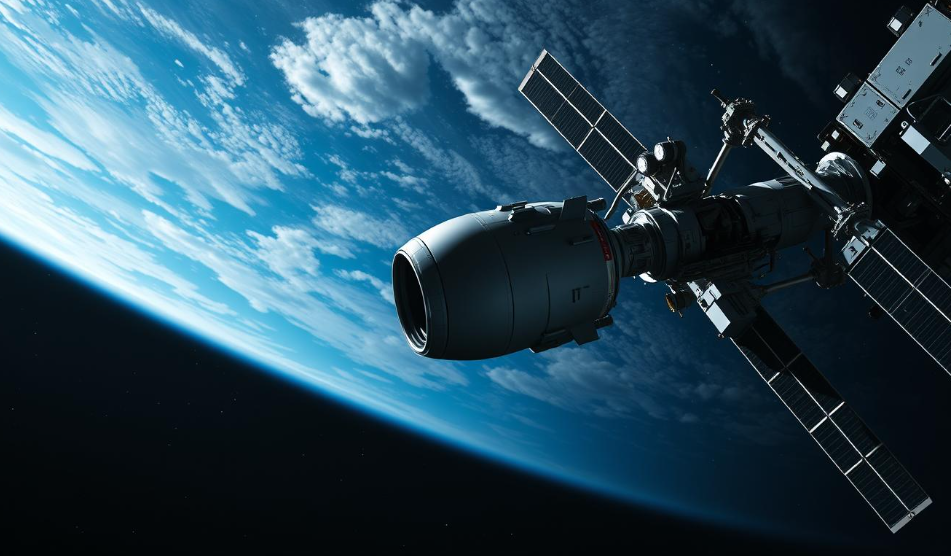SpaceX halts Falcon-9 launches after issue on Sunita Williams’ rescue mission
SpaceX has stopped all Falcon-9 rocket launches for now. This is because of a problem during a mission to get astronauts Sunita Williams and Butch Wilmore back from the International Space Station (ISS). The Falcon-9’s second stage had an “off-nominal deorbit burn,” which made it land far from where it was supposed to.
SpaceX is taking a break from launching Falcon-9 rockets. They want to figure out what went wrong on the Crew-9 mission. They promise to start launching again only when they’re sure it’s safe for everyone involved.
Key Takeaways
- SpaceX has halted Falcon-9 launches after an issue during the Crew-9 mission to retrieve astronauts Sunita Williams and Butch Wilmore from the ISS.
- The Falcon-9’s second stage experienced an “off-nominal deorbit burn,” causing it to land outside the targeted ocean area.
- SpaceX is working to understand and address the root cause of the problem before resuming Falcon-9 launches.
- The decision to suspend launches is a precautionary measure to ensure the safety and reliability of SpaceX’s launch systems.
- The successful retrieval of Williams and Wilmore from the ISS remains a top priority for the company.
SpaceX’s Crew-9 Mission: Retrieving Stranded Astronauts
SpaceX launched the Crew-9 mission on September 29th, 2024. It aimed to rescue Sunita Williams and Butch Wilmore from the International Space Station (ISS). They had been there for over eight months. The delay was due to problems with the Boeing Starliner spacecraft.
Falcon-9 Rocket Launches Crew Dragon Spacecraft
The Falcon-9 rocket launched the Crew Dragon spacecraft. It carried NASA’s Nick Hague and Russian cosmonaut Alexander Gorbunov to the ISS. The launch was delayed by two days because of bad weather.
Normally, Crew Dragon has four crew members. But for this mission, two seats were left empty. They were kept for Williams and Wilmore’s return in February 2025.
Sunita Williams and Butch Wilmore’s Extended Stay
Sunita Williams is a veteran astronaut. She holds the record for the most spacewalks by a woman. Butch Wilmore has piloted the Space Shuttle Atlantis and made the first 3D printed tool in space.
They have been on the ISS for over 100 days longer than planned. They were waiting for the Crew-9 mission to rescue them.
“The Crew-9 mission carried only two crew members on the outbound leg, Nick Hague and Roscosmos cosmonaut Aleksandr Gorbunov, while the return flight will include the rescued astronauts Sunita Williams and Butch Wilmore in 2025.”
| Astronaut | Mission | Highlights |
|---|---|---|
| Sunita Williams | Crew-9 Mission | Record for most spacewalks by a woman, over 50 hours in space |
| Butch Wilmore | Crew-9 Mission | Piloted Space Shuttle Atlantis, involved in first 3D printed tool in space |
Challenges and Complications
Boeing’s Starliner Issues and Setbacks
The Crew-9 mission was a response to Boeing’s Starliner problems. The Starliner had issues, like a failed test flight in 2019. It veered off course and couldn’t dock with the International Space Station (ISS).
After a successful second test flight, the Starliner still had problems. It had reduced thrust in its jets. This made it hard for astronauts Sunita Williams and Butch Wilmore to return safely.
NASA decided to launch the Crew-9 mission to bring the astronauts back. But, the Boeing Starliner issues kept causing problems and delays.
- The Boeing Starliner has been at the station for two months, longer than planned.
- NASA is checking data from tests of the spacecraft’s thrusters after some failed in June.
- There’s disagreement among NASA officials about the safety of returning astronauts Butch Wilmore and Suni Williams.
Despite these issues, Boeing believes the Starliner can safely return the crew. They support NASA’s request for more testing. But, the problems have caused big delays and uncertainty about when the astronauts will return.
“Boeing has confidence in the Starliner spacecraft’s ability to return safely with crew and continues to support NASA’s requests for additional testing.”
The Crew-9 mission was set for February 2025. But, the Boeing Starliner problems have made the timeline uncertain. The FAA investigation into the recent issue will take weeks or months, adding to the uncertainty.
Falcon-9’s Successful Launch and Deployment
The Falcon-9 rocket, SpaceX’s main launch vehicle, has shown its reliability again. It launched from the Cape Canaveral Space Force Station in Florida. This launch was special because it was the first human spaceflight from pad 40. The Crew Dragon spacecraft flew directly to the International Space Station (ISS).
The Falcon-9 rocket, on its second flight, carried the spacecraft through the dense lower atmosphere. The first stage landed back at the Space Force station just 7 minutes and 40 seconds after launch. Then, the Crew Dragon went on to meet the ISS on its own, continuing the mission smoothly.
| Falcon 9 Launch Statistics | Value |
|---|---|
| Total Launches | 379 |
| Successful Launches | 376 |
| Maximum Payload to LEO | 22,800 kg (expended) |
| Maximum Payload to GTO | 8,300 kg (expended) |
| Cost per Launch (2024 est.) | $69.75 million |
The Falcon-9 has a success rate of over 96%. It’s a reliable and affordable launch option for many missions. This latest success shows the Falcon-9’s importance in the commercial space industry. It helps pave the way for more space exploration and use.
As the Crew Dragon heads to the ISS, SpaceX and NASA teams are excited. They’re waiting for the safe arrival and docking of the spacecraft. This is another big step in the partnership between private and public sectors in space exploration.
Mission Objectives and Crew Composition
The Crew-9 mission aimed to send vital supplies and two empty seats to the International Space Station (ISS). This was to help Sunita Williams and Butch Wilmore return. The crew included NASA astronaut Nick Hague as commander and Russian cosmonaut Alexander Gorbunov on his first space trip.
Nick Hague and Alexander Gorbunov’s Roles
Hague, a seasoned F-16 test pilot and combat veteran, was picked for his space experience. He was ready for the mission’s unique challenges. Gorbunov, though not the pilot, was there to help Hague during the flight’s tough parts.
| Crew Member | Role | Experience |
|---|---|---|
| Nick Hague | Commander | Experienced NASA astronaut, F-16 test pilot, and combat veteran |
| Alexander Gorbunov | Mission Specialist | Inaugural spaceflight, providing extra support for Hague |
The Crew-9 mission is part of NASA and SpaceX’s partnership. It ensures astronauts get to the ISS safely. With Hague and Gorbunov leading, the mission is set to achieve its goals and push space exploration forward.
Integrating Wilmore and Williams into Crew Dragon Operations
When the SpaceX Crew-9 spacecraft reached the International Space Station (ISS), the main goal was to get Sunita Williams and Butch Wilmore ready for return. They had little training on the Crew Dragon. But, the ground teams worked hard to teach them how to safely come back to Earth in February 2025.
Getting these two seasoned astronauts into the Crew-9 crew is key to the mission’s success. The Crew-9 mission was meant for four people. But, it’s now for just two, Stephanie Wilson and Zena Cardman, to make room for Wilmore and Williams.
This change from a two-person crew to a four-person crew at landing is a big challenge. It needs great teamwork and clear communication. A backup plan ensures at least one crew member from each country stays on the ISS. This is to keep a crew ready for emergencies.
| Crew Member | Role | Mission Duration |
|---|---|---|
| Stephanie Wilson | Crew-9 Astronaut | Approximately 262 days |
| Zena Cardman | Crew-9 Astronaut | Approximately 262 days |
| Sunita Williams | Integrated Crew Member | Approximately 262 days |
| Butch Wilmore | Integrated Crew Member | Approximately 262 days |
The inclusion of Sunita Williams and Butch Wilmore in the Crew Dragon operations is vital. It ensures the mission’s success, despite the challenges of their long stay in space.
Contingency Plans and Crew Rotation Strategies
NASA and its partners showed great flexibility during the Crew-9 mission. When Sunita Williams and Butch Wilmore had to stay longer on the International Space Station (ISS), they quickly came up with plans. These plans kept the ISS safe and running smoothly.
One important strategy is rotating the ISS crew every six months. This keeps astronauts from the US and Russia on the station all the time. It helps them handle any unexpected problems or emergencies.
| Contingency Plan | Description |
|---|---|
| Crew Rotation | Astronauts from the US and Russia rotate through the ISS every 6 months to maintain a continuous presence. |
| Backup Launch Options | Multiple launch providers, including SpaceX and Boeing, ensure alternative means of transporting crew to the ISS. |
| Contingency Habitats | The ISS has designated contingency habitats and resources to accommodate unexpected situations. |
Also, the commercial crew program has backup plans. SpaceX and Boeing can launch astronauts to the ISS if needed. This means the station can always be staffed, no matter what happens.
The Crew-9 mission showed how well NASA and its partners plan for surprises. Their strategies keep the ISS running smoothly. It’s a key place for science and exploration.
The Future of Commercial Space Exploration
The Crew-9 mission on the SpaceX Falcon-9 rocket shows the company’s dedication to safety and efficiency. This mission, along with the Crew Dragon’s development, shows private space companies’ growing role in space travel.
The future of space travel looks bright. It promises reliable, affordable, and innovative ways to explore space. Recent numbers show the industry’s fast progress:
- 51 humans have flown on commercial vehicles to low Earth orbit.
- 2020 was the first year a commercial vehicle flew to the space station.
- NASA is funding three companies to build commercial space stations.
- SpaceX launched 84 times in 2023, showing their dedication to space access.
The Falcon-9 rocket by SpaceX has changed the game. Since 2010, it has been a reliable and affordable way to send payloads to space. The Starlink satellite constellation is also changing global internet, with over two million subscribers by September 2023.
“SpaceX was founded in 2002 by Elon Musk with the goal of expanding humanity into space.”
The future of commercial space exploration is exciting. Companies are working with NASA to send science and technology to the Moon starting in 2023. SpaceX and others are also working on human landing systems for NASA’s Artemis mission to the Moon.
Even with the Falcon-9 grounded due to an issue, the industry is moving forward. The Federal Aviation Administration is looking into SpaceX’s safety request. The company’s busy schedule, including astronaut launches and commercial missions, shows their ongoing role in space exploration.
Conclusion
The SpaceX Crew-9 mission showed the company’s skill in handling tough challenges. It also supported a vital rescue effort. Despite a problem with the Falcon-9‘s second stage, SpaceX worked hard to find and fix the issue. This shows their focus on safety and reliability.
The rescue of Sunita Williams and Butch Wilmore is a big win for the space industry. They had been stuck on the International Space Station for over eight months. This success proves the industry’s ability to adapt and overcome obstacles.
The Falcon-9 rocket’s launch and the team’s quick response are impressive. They showed the growth and skill of the commercial space sector. This mission also showed how well private and government teams work together. It ensured the astronauts’ safety during a critical time.
FAQ
Why has SpaceX halted further launches of its Falcon-9 rocket?
SpaceX stopped launching its Falcon-9 rocket after a recent mission. The mission aimed to retrieve astronauts Sunita Williams and Butch Wilmore from the ISS. The rocket’s second stage had an “off-nominal deorbit burn,” landing it outside the target area.
SpaceX will not launch again until it figures out and fixes the problem.
What was the purpose of the Crew-9 mission?
The Crew-9 mission aimed to bring back Sunita Williams and Butch Wilmore from the ISS. They had been there for over eight months due to Boeing Starliner issues. The Falcon-9 rocket launched the Crew Dragon with a two-man crew to the ISS.
What were the ongoing issues with the Boeing Starliner spacecraft that led to the Crew-9 mission?
Boeing faced many problems, including a failed test flight in 2019. The Starliner couldn’t dock with the ISS. A repeat test was successful but had thrust issues, keeping Williams and Wilmore stranded.
NASA decided to launch the Crew-9 mission to bring them back.
How did the Falcon-9 rocket perform during the Crew-9 mission?
The Falcon-9 rocket launched from Florida’s Cape Canaveral Space Force Station. It was the first human spaceflight from pad 40. The rocket went directly to the ISS’s path.
After going through the dense atmosphere, the first stage landed back at the Space Force station. This happened 7 minutes and 40 seconds after launch.
Who were the crew members of the Crew-9 mission?
The crew included NASA’s Nick Hague as commander and Russian cosmonaut Alexander Gorbunov. Hague, an experienced pilot, was chosen for his space experience. Gorbunov was there to support Hague during flight.
How were Sunita Williams and Butch Wilmore integrated into the Crew-9 mission?
Sunita Williams and Butch Wilmore will join the Crew-9 spacecraft at the ISS. They will have to learn how to use the Crew Dragon to return to Earth. Ground teams are working to help them understand their tasks.
How did NASA and its partners demonstrate their ability to adapt to changing circumstances?
NASA and its partners showed they can adapt without risking the ISS’s safety. They have plans for crew rotations every six months. This ensures astronauts from the U.S. and Russia stay on the ISS.
What is the future of commercial space exploration in light of the Crew-9 mission?
The Crew-9 mission shows SpaceX’s dedication to safe space travel. It highlights the growth of private space companies in human spaceflight. The future looks promising for reliable and innovative space exploration.











